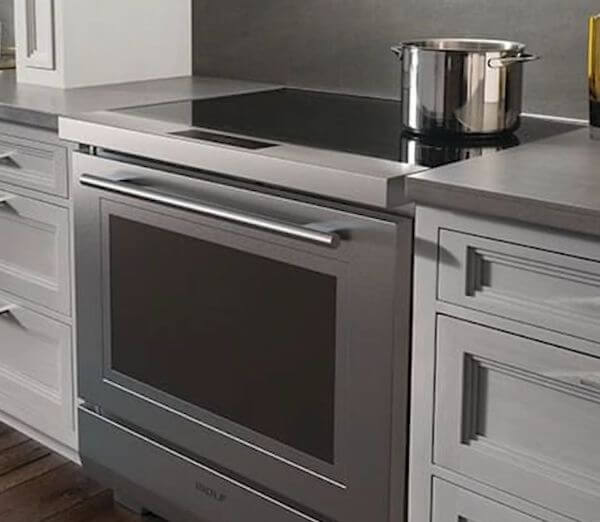Induction ranges have been touted as the best cooking product you can buy.
Technology is the best, better than electric and gas cooking in almost every case. But, is induction better for you?
Induction may not be for you and the way you cook. And many people can’t buy induction. You don’t want to find that out when you’re installing.
This article will be about the pros and cons of induction versus gas and electric.
Part two will look at features and what to look for in induction range. Part three will be about the best induction ranges to consider.
So let’s get started.
Table of Contents
How Induction Works
Let me explain the difference between electric and induction with just this one story.
I just moved, and now I have a Kenmore elite electric stove instead of a pro gas range. Wanted to try a new pantsiered salmon recipe, turned the range on to what I thought was medium-high and waited.
Then I added butter and avocado oil and probably smoked out of my apartment, setting off the alarms.
I had to remove the pan from the stove and wait for the burner to cool down.
Electric heat is residual because it heats the glass and the glass heats the food.
I could have left the pan on the surface with induction, turned the heat for an instant simmer.
In induction, the pan cooks the food, bypassing the glass. Induction uses magnetic heat, the magnets can sight the metal of your cookware with a pan cooking the food.
That’s why induction cooktops only work with pots and pans made of ferrous metals like iron and steel.
Pros
Induction is efficient and fast. It’s faster than the fastest pro range at 25,000-30,000 BTU.
Induction is the newest cooking technology, introduced in the 1980s. Gas hasn’t changed much since the 1920s.
The burner may have more output, but 40% is lost as heat.
Induction is an instant simmer. Induction bypasses the glass to provide an instant simmer.
Food doesn’t bake on that cooktop because the glass doesn’t heat, so cleaning is much easier.
Induction requires less venting because you have less heat escaping from side burners, like a gas range.
It may not seem like a big deal, but Massachusetts and other states have makeup laws, so any vent of a 400 CFM needs a fresh air return.
You could buy this 36 inch pro range with induction or even with sous vide and still be within a 400 CFM. You can’t properly vent an equivalent gas range at 400, you’ll probably need more.
We’ve written articles about gas cooking and the number of toxic gases generated while cooking, such as carbon monoxide, formaldehyde, nitrous oxide, and carbon dioxide.
Along with better built homes and higher BTU ranges, your indoor air is probably worse than the outside. If you cook often, it could be a lot worse.
Then you have numerous gas leaks throughout the system and perhaps even your house.
So environmentally, induction is a better option for your house and probably the planet.
My six-year-old can easily turn on a gas or electric range, but not induction. It needs metal to activate. Similarly, it’s hard for her to burn on induction top.
The glass only has residual warmth from the pan. For gas or electric ranges, scalding is much more of a concern.
Cons
Gas requires less than twelve amps, while induction requires up to 50 amps.
If you live in an older building or condo, you may not have the amperage you need to power your induction range.
At the very least, you may need a new electric line to the range and maybe a new panel and service.
An induction range will cost more than the equivalent gas range and far more than a radiant electric range.
Gas ranges are more reliable at 6.4% versus 9.6% for induction ranges based on our over 40,000 service calls logged by our service department last year.
Much of the service for induction is from electric spikes shorting out the ranges.
You see the gas when it’s on, you want to toss the pan with the food up like a restaurant? You can do that with gas.
In induction and you don’t shut off and the magnets do not sense metal.
Some people commented you can heat up some tortillas over gas flame, which you can’t do with induction.
In larger pro ranges, you have grill, griddle, French top and sous vide options that you can’t buy in induction.
Gas ovens also have gas broilers and are better than the electric element.
Induction also sends electromagnetic radiation and could interfere with your pacemaker.
Check with your doctor before buying an induction range.
Key Takeaways
Those are the pros and cons of induction.
Basically, it’s faster, way better to simmer with, easier to vent and more child cafe. Induction is also better for the environment.
However, induction requires more power. It may not be the right choice for every cooking style.

